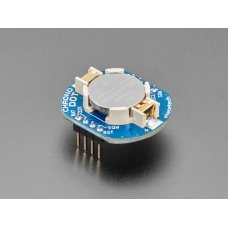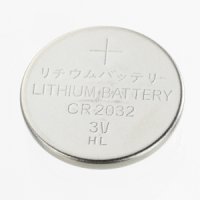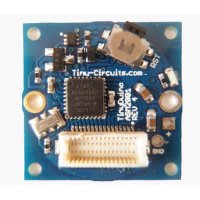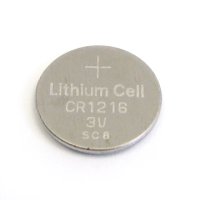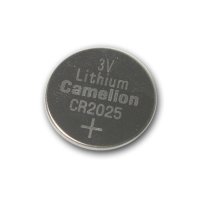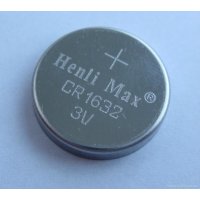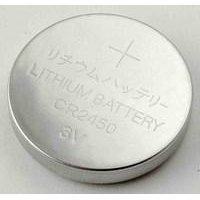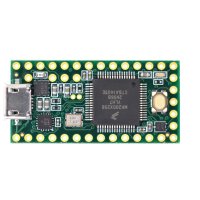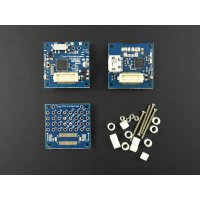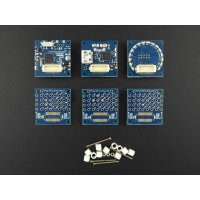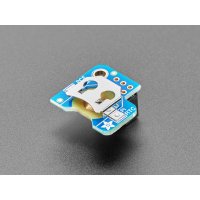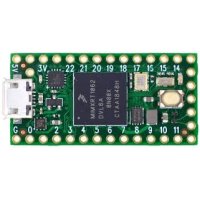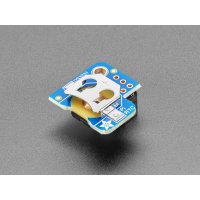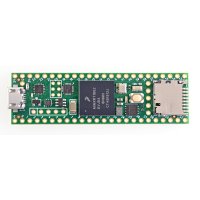The ChronoDot V3 is the latest version of macetech’s popular ChronoDot line of products. Designed during the Great Chip Shortage, it uses the newly-released MAX31328 temperature-compensated real-time clock chip. However, it remains pin- and code-compatible with the older DS3231-based ChronoDots, and has the same clock accuracy and drift specifications. The MAX31328 chip is also in a smaller package, which allowed a few additional enhancements to the design.
- Controller: Maxim MAX31328
- Function: Temperature-compensated RTC
- Accuracy: ± 3.5ppm at -40C to +85C (~1 minute per year)
- Power Supply: 2.3 to 5.5 V DC
- Current: 200uA (active), 820nA (timekeeping)
- PCB Size: 1.2 x 1.0 inches (30.5 x 25.8 mm)
- Pin Spacing: 0.1 inches
- Header Spacing: 0.9 inches
Arduino Examples:
Very simple Arduino code to read and print the hours, minutes, and seconds from the ChronoDot:
#include <Wire.h>
void setup()
{
Wire.begin();
Serial.begin(9600);
// clear /EOSC bit
// Sometimes necessary to ensure that the clock
// keeps running on just battery power. Once set,
// it shouldn't need to be reset but it's a good
// idea to make sure.
Wire.beginTransmission(0x68);
Wire.write(0x0E); // select register
Wire.write(0b00011100); // write register bitmap, bit 7 is /EOSC
Wire.endTransmission();
}
void loop()
{
// send request to receive data starting at register 0
Wire.beginTransmission(0x68); // 0x68 is DS3231 device address
Wire.write((byte)0); // start at register 0
Wire.endTransmission();
Wire.requestFrom(0x68, 3); // request three bytes (seconds, minutes, hours)
while(Wire.available())
{
int seconds = Wire.read(); // get seconds
int minutes = Wire.read(); // get minutes
int hours = Wire.read(); // get hours
seconds = (((seconds & 0b11110000)>>4)*10 + (seconds & 0b00001111)); // convert BCD to decimal
minutes = (((minutes & 0b11110000)>>4)*10 + (minutes & 0b00001111)); // convert BCD to decimal
hours = (((hours & 0b00100000)>>5)*20 + ((hours & 0b00010000)>>4)*10 + (hours & 0b00001111)); // convert BCD to decimal (assume 24 hour mode)
Serial.print(hours); Serial.print(":"); Serial.print(minutes); Serial.print(":"); Serial.println(seconds);
}
delay(1000);
}- 1 x Adafruit 255 ChronoDot - Ultra-precise Real Time Clock - v3
Adafruit 255 ChronoDot - Ultra-precise Real Time Clock - v3
- Brand: Adafruit
- Product Code: Ada-ChronoDot-Time-Clock-v3
- Reward Points: 22
- Availability: In Stock
-
रo 2,125.00
- Price in reward points: 2240
-
- 60 or more रo 2,115.00
Related Products
Coin Cell Battery - CR2032
aka 5004LC, the most common coin cell, commonly used in RTCs and other circuits requiring timer back..
रo 39.00
TinyDuino Processor Board (with Coin Cell Holder)
The Heart of the TinyDuino Platform! The TinyCircuits TinyDuino is an Arduino compatible board i..
रo 1,364.00
Coin Cell Battery - Lithium CR1216
CR1216 (5034LC) Lithium Coin Cell Battery Specifications: Type: Lithium MnO2 V..
रo 23.00
Coin Cell Lithium Battery CR2025
CR2025 (KCR2025) Lithium Coin Cell Battery Specifications: Type: Lithium MnO2 ..
रo 40.00
Coin Cell Lithium Battery CR1632
CR1632 (also known as DL1632, ECR1632, LM1632, 1632, KCR1632, BR1632, KL1632, L1632, E-CR1632, KECR1..
रo 24.00
Coin Cell Lithium Battery CR2450
CR2450 3V lithium button cell battery, coin cell batteries, high capacity. Specifications: ..
रo 75.00 रo 112.00
Teensy 3.2
Teensy 3.2 features a 32 bit ARM processor. Teensy 3.2 is a direct, 100% compatible replacement ..
रo 1,730.00 रo 2,005.00
TinyDuino Basic Kit - Coin Cell version
This TinyDuino Basic Kit has the bare essentials to get going with the TinyDuino! This kit comes wi..
रo 2,992.00
TinyDuino Starter Kit - Coin Cell Version
This TinyDuino Starter Kit is a great way to start with your TinyDuino and begin creating some cool ..
रo 4,698.00
Adafruit 3386 PiRTC - PCF8523 Real Time Clock for Raspberry Pi
This is a great battery-backed real time clock (RTC) that allows your Raspberry Pi project to keep t..
रo 724.00 रo 809.00
Teensy 4.0 Development Board
Teensy 4.0 is the latest Teensy, offering the fastest microcontroller and powerful peripherals in th..
रo 2,505.00
Adafruit 4282 PiRTC - Precise DS3231 Real Time Clock for Raspberry Pi
This is the best battery-backed real time clock (RTC) you can get that allows your Raspberry Pi proj..
रo 1,614.00
Teensy 4.1 Development Board
Teensy 4.1 features the fastest micocontroller and an expanded set of powerful peripherals in a 2.4 ..
रo 3,114.00

